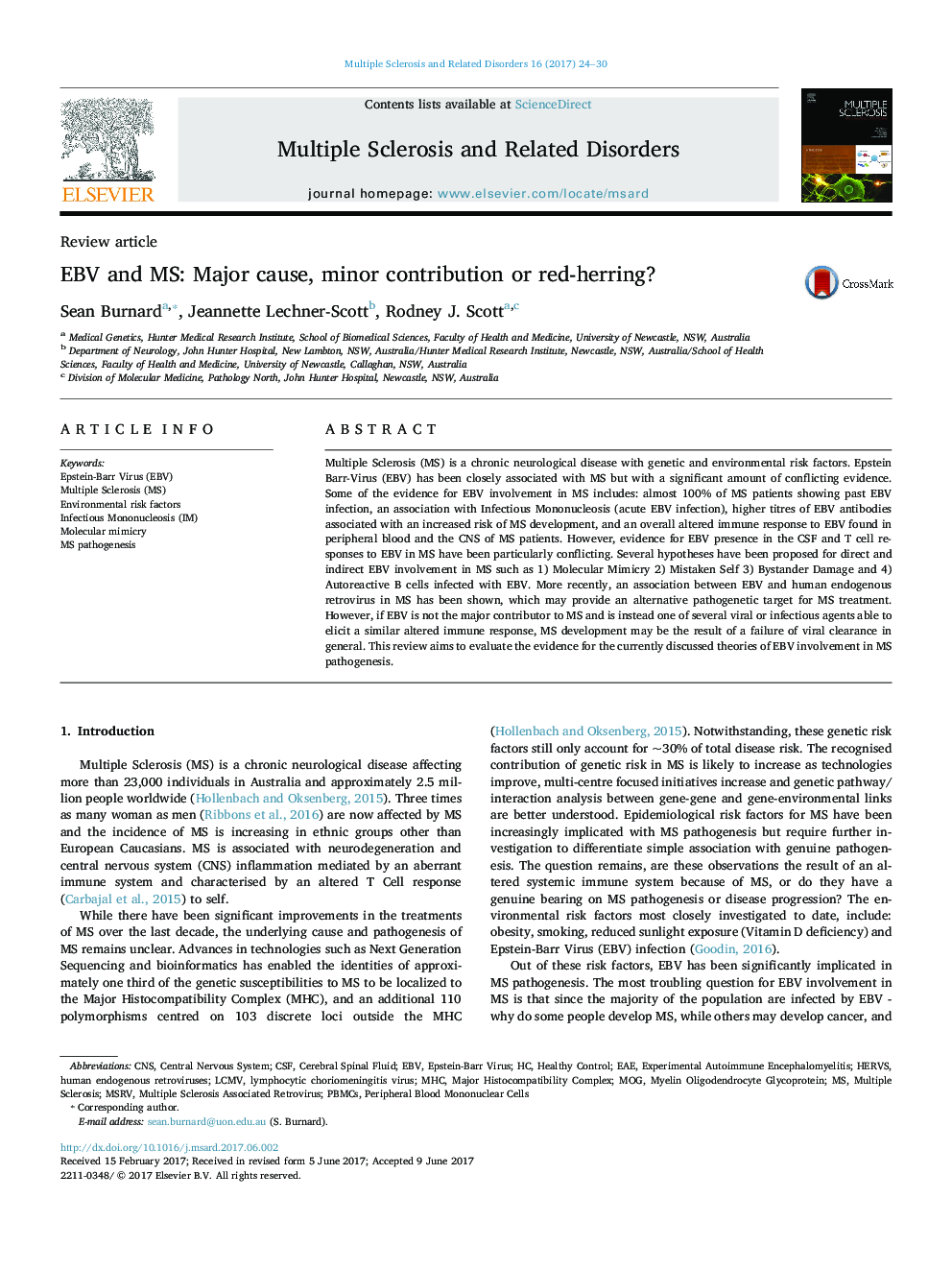| کد مقاله | کد نشریه | سال انتشار | مقاله انگلیسی | نسخه تمام متن |
|---|---|---|---|---|
| 5590886 | 1570201 | 2017 | 7 صفحه PDF | دانلود رایگان |
عنوان انگلیسی مقاله ISI
EBV and MS: Major cause, minor contribution or red-herring?
دانلود مقاله + سفارش ترجمه
دانلود مقاله ISI انگلیسی
رایگان برای ایرانیان
کلمات کلیدی
PBMCsHERVsLCMVEAEMSRVMOGexperimental autoimmune encephalomyelitis - آنسفالومیلیت خودایمنی تجربیEBV - اپشتین بار ویروسMolecular mimicry - تقلید مولکولیCNS - دستگاه عصبی مرکزیHuman endogenous retroviruses - رتروویروسهای انسانی انسانیperipheral blood mononuclear cells - سلول های تک هسته ای خون محیطیCerebral Spinal Fluid - سیالات مغزی نخاعیcentral nervous system - سیستم عصبی مرکزیEnvironmental risk factors - عوامل خطر زیست محیطیCSF - مایع مغزی نخاعیmajor histocompatibility complex - مجموعه سازگاری بافتی اصلیMHC - مجموعه سازگاری بافتی اصلیMultiple sclerosis (MS) - مولتیپل اسکلروز (MS)Multiple sclerosis - مولتیپل اسکلروزیس(ام اس)Epstein-Barr virus - ویروس Epstein-BarrEpstein-Barr virus (EBV) - ویروس اپستین بار (EBV)Lymphocytic choriomeningitis virus - ویروس کوریومنژنینگ لنفوسیتیکhealthy control - کنترل سالمmyelin oligodendrocyte glycoprotein - گلیکوپروتئین الیگودندروسیت میلین
موضوعات مرتبط
علوم زیستی و بیوفناوری
بیوشیمی، ژنتیک و زیست شناسی مولکولی
ژنتیک
پیش نمایش صفحه اول مقاله

چکیده انگلیسی
Multiple Sclerosis (MS) is a chronic neurological disease with genetic and environmental risk factors. Epstein Barr-Virus (EBV) has been closely associated with MS but with a significant amount of conflicting evidence. Some of the evidence for EBV involvement in MS includes: almost 100% of MS patients showing past EBV infection, an association with Infectious Mononucleosis (acute EBV infection), higher titres of EBV antibodies associated with an increased risk of MS development, and an overall altered immune response to EBV found in peripheral blood and the CNS of MS patients. However, evidence for EBV presence in the CSF and T cell responses to EBV in MS have been particularly conflicting. Several hypotheses have been proposed for direct and indirect EBV involvement in MS such as 1) Molecular Mimicry 2) Mistaken Self 3) Bystander Damage and 4) Autoreactive B cells infected with EBV. More recently, an association between EBV and human endogenous retrovirus in MS has been shown, which may provide an alternative pathogenetic target for MS treatment. However, if EBV is not the major contributor to MS and is instead one of several viral or infectious agents able to elicit a similar altered immune response, MS development may be the result of a failure of viral clearance in general. This review aims to evaluate the evidence for the currently discussed theories of EBV involvement in MS pathogenesis.
ناشر
Database: Elsevier - ScienceDirect (ساینس دایرکت)
Journal: Multiple Sclerosis and Related Disorders - Volume 16, August 2017, Pages 24-30
Journal: Multiple Sclerosis and Related Disorders - Volume 16, August 2017, Pages 24-30
نویسندگان
Sean Burnard, Jeannette Lechner-Scott, Rodney J. Scott,